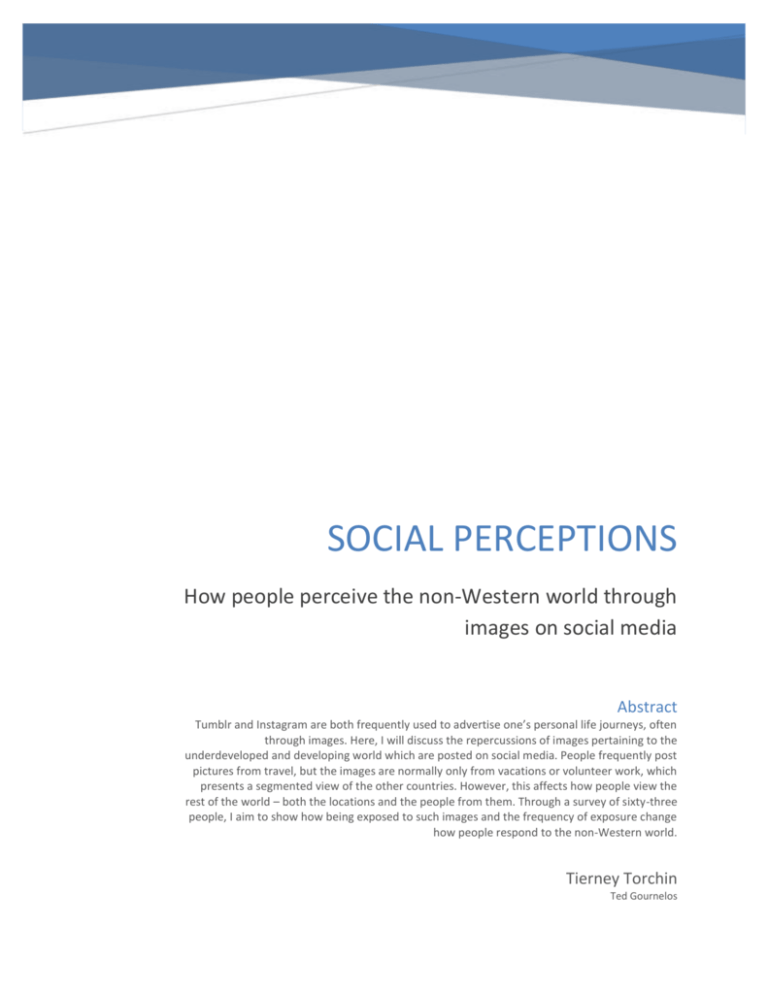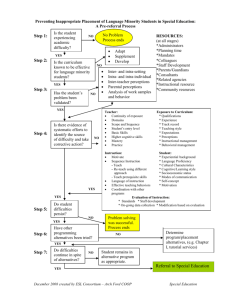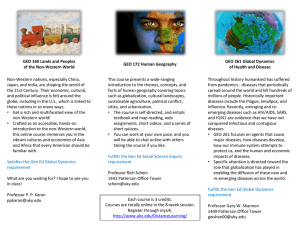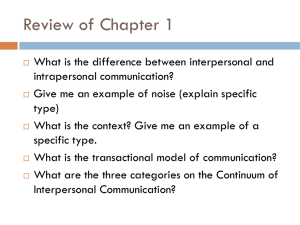Social perceptions
advertisement

SOCIAL PERCEPTIONS How people perceive the non-Western world through images on social media Abstract Tumblr and Instagram are both frequently used to advertise one’s personal life journeys, often through images. Here, I will discuss the repercussions of images pertaining to the underdeveloped and developing world which are posted on social media. People frequently post pictures from travel, but the images are normally only from vacations or volunteer work, which presents a segmented view of the other countries. However, this affects how people view the rest of the world – both the locations and the people from them. Through a survey of sixty-three people, I aim to show how being exposed to such images and the frequency of exposure change how people respond to the non-Western world. Tierney Torchin Ted Gournelos 1 Introduction It is nearly impossible for one to completely isolate themselves from social media. Even without any specific sites, it has saturated itself throughout America. This means everyone gets insight into the lives of their friends – from what food they’re eating at a random diner to their adventures and explorations. The pictures involving other countries may be seen as interesting or expanding one’s understanding of other cultures, but I seek to explain how they can additionally be problematic. Generally, there is segmentation between the photographed world and the truth of how different parts of the world function. The question posed is how images in social media change perceptions of the developing and underdeveloped (third) world. Through a survey, I sought to discover how individuals’ views change towards other nations and towards people from different racial or ethnic backgrounds due to their exposure to particular image paradigms via social media. Literature Review This question holds significant importance in a day and age where there is such a large racial divide reopening within America and the western world. There has, thus far, been plenty of research on the subject, each looking from a different point of view. In the media, it has become trendy to present caricatures of nations in order to seek international aid or gain the interest of a western audience (Gabriel-Ellis). However, this is not a new trend; one can trace back the belittlement of other cultures nearly infinitely, but particularly in Africa, the strengthening of this argument can be traced back to 1828 when German historian Georg Hegel, who claimed that African history should be forgotten because it plays no part in contemporary culture. This has extended to today, as is proven in studies where people play word associations. When Africa comes up, it is still associated with words such as “war” and “corruption”. Negative perceptions SOCIAL PERCEPTIONS | How people perceive the non-Western world through images on social media 2 of Africa spread to negative ideas of associated features, such as blackness, where skin bleaching has become common to become more culturally acceptable in the western world (Asante 2013). Additionally, culturally painted images become fact in the eye of the beholder. The repetition of certain ideas such as war-divided countries and misguided peoples sways mass populations into believing that this is the only accurate portrayal of other nations (Wallace 2005). Media is swaying our portrayals, but social media takes it one step further by swaying how we then interact with non-western nations. Social media has led to very different trends in travel; people are taking virtual tours of other countries and seeing more locations. Additionally, seeing images from countries leads to repeat visits, as can be seen in Thailand, which has become one of the most viral countries in the world (Xiang 2010). These well-intentioned individuals are viewing the world through a specific lens of either volunteer work or vacation and creating a mental image of what the country is before travel. This can lead to cultural exploitation, where the locales are forced into change by tourists who think that the social structure is problematic due to prior images (Ruxin 2010) – but regardless of the implications, it proves that social media has an impact on where and how travel is taking place, as well as how people are viewing the countries as a whole. Method In order to study how social media images change perceptions, I conducted a survey of sixty-five individuals. This was a convenience sampling, posted on my Facebook and Tumblr – though most of my replies were from randomized individuals via Tumblr sharing. My sample was largely female, white United States citizens aged 25 and under. I asked a series of questions ranging from perceptions of images to basic knowledge on other countries, which is included in SOCIAL PERCEPTIONS | How people perceive the non-Western world through images on social media 3 the appendices (fig 1). This survey was posted on Qualtrics and was completely anonymous so that the answers would reflect actual opinions instead of feeding into mob mentalities. Results This survey did not prove as useful as initially intended, though it did provide some basic data. I used age as a signifier for internet use because while not completely accurate, the youth demographic uses social media at a much higher rate and for more extended periods of time than any other group (Pew Research 2014). One of the first things I noticed was the increased negativity amongst younger participants. There were more words implying negative correlations with images and with helping in other countries as the group got younger. They found the image involving tigers in a temple problematic (fig 2), as well as the image depicting a white volunteer in an African village (fig 4). They had better views of the image with kids playing with a dog (fig 3). However, throughout, there was more negativity. Words among the younger audience included “fake” and “wrong”. There were higher rates of individuals disliking images within younger demographics, and there was increased pessimism that it even helps. There was also a decrease in general knowledge on underdeveloped nations in the younger audience. Those who had travelled more found the images involving tourism and voluntourism more problematic than those who had seen less of the world. Lastly, I found some strange converse relationships between seeing images of friends travelling and believing that volunteering helps. Those who saw images of friends travelling regularly also thought that volunteering in third world countries is not particularly helpful. Discussion Most of my findings validated what I had believed would occur. Those from younger demographics tend to be more exposed to images of other countries set within two main frames. SOCIAL PERCEPTIONS | How people perceive the non-Western world through images on social media 4 One is that of the white savior, in which people from the western world go on a noble quest to save the Others in an underdeveloped world. The Other is described as a non-dominant group whose identity is considered to be different in a negative way in comparison to the in-group (Staszak 2008). The second is through a vacation lens, where the exotic locations are filled with more otherness, as well as foreign activities not common to the western world. Through these two lenses, the internet-heavy demographic is left with no choice but to assume that other countries are filled with people living in a way unlike them. This results in a negativity pointed towards the other, for the lifestyle they are living is deemed lesser due to the differences. These are the same negative correlations presented earlier, where images have led to a word association when presented with the concept of Africa (Gabriel-Ellis). The issues are not isolated to Africa, either. Negative associations of a group of people are directly linked with racism in the western world (Asante 2013). The correlation between skin color and specific regions causes people to drag feelings of racism from images viewed into their day-to-day lives. The younger demographic is not only being exposed to these images more frequently, but also knows less about the rest of the world in general. The two lenses are possibly sculpting an entire worldview for those looking through it. The survey revealed that as ages got younger, statistical guesses got further from the truth in general. Youths assumed that Africa had higher levels of poverty and were also less capable of naming countries outside of the western world. They were also more inclined to answer “Africa” when I asked which country they thought a specific picture was taken in, even though Africa is a continent. This type of ignorance coupled with a skewed view of life in non-western countries is a cocktail that can lead to unintentional racism based off of a misunderstanding of other cultures. SOCIAL PERCEPTIONS | How people perceive the non-Western world through images on social media 5 Another negative side-effect of the results is the negativity. Younger audiences are being exposed to specific images. The picture showing children playing with a dog represented a common trope among images of other countries, wherein the landscape is barren and the lifestyle, even when similar, looks altogether different from the western world. Large quantities of images expose rural environments such as this, or villages where people are in need of food, water, schooling, or other basic needs. This is through social media when people go on mission trips or other programs abroad; but it also saturates televisions in the form of commercials to donate. Rather than inspiring youth audiences, my survey shows a trend to increase hopelessness, which has been expanded upon in other research (Wallace 2005). Social media is completely changing how we interact with other communities. Not only is there the mass globalization that is so common on news like exposing problems affecting all of Africa, but there is more of an opportunity for exposure of culture through localized pictures (Servaes and Lie 2008). This is beneficial because it is showing isolated or smaller communities, but is just increasing the likelihood of segmented messages being spread, as small places in need of service are depicted frequently while larger cities in the non-western world are largely unseen. This repetition of localized images leads to the apathy seen in the world at large and seen in my survey through those who see images of travel frequently. The main section that my survey was lacking was an understanding of time spent on social media as well as what mediums most frequently are used. I realized while analyzing my results that many people in younger age groups may have been found via Tumblr, and also that Tumblr audiences and Facebook users share different value systems. Facebook is more across the board when it comes to political leanings and views of the world, while Tumblr takes a very liberal approach. Being able to distinguish here would have been valuable. Additionally, hours SOCIAL PERCEPTIONS | How people perceive the non-Western world through images on social media 6 spent online daily would have been a good question to ask. I was able to extrapolate based on age, but those exposed more frequently within each age group may have different points of view or understandings. However, the data received was able to make do. If I were to do the study again, I would edit the content to reflect these changes and to gain more insight as to social media consumption. I also took off captions to bring the images out of context, but the context may have been interesting to analyze as well. My research is studying how images on social media affect our views of non-western countries, but the context does play an important role in how the message of the image is received. Still, this survey allowed for insight as to how people take in information. I can conclude that images play a slight role in our perceptions, where those who take in snippets of information from social media feel more negativity and hopelessness towards underdeveloped and developing nations, while simultaneously having less knowledge on the regions. Also, I can conclude that those who claim to see images of friends volunteering frequently within any age group feel more negatively about the benefits of volunteering in third world countries. The skewed bits of information received via social media are painting only two pictures. While volunteering is generally helpful and tourism is a fun activity, gaining one’s insight to the rest of the world through the travel of others can lead to large gaps in knowledge, misconceptions, and an overall negative outcome for the part of the world that needs exposure the most. SOCIAL PERCEPTIONS | How people perceive the non-Western world through images on social media 7 Bibliography Asante, Molefi. 2013. “The Western Media and Falsification of Africa: Complications of Value and Evaluation.” China Media Research vol 9:2. Gabriel-Ellis, Nathaniel. 2011. “What role does media play in shaping western perceptions of 3rd world countries?” PhD dissertation. Lenhart, Amanda, et al. 2010. “Social Media and Mobile Internet Use Among Teens and Young Adults.” Pew Internet and American Life Project, 1-37. Pew Research Center. 2014. “Social Networking Fact Sheet.” http://www.pewinternet.org/factsheets/social-networking-fact-sheet/ Ruxin, Josh. 2010. “Tourism in the Developing World - Beneficial or Exploitative?” Huffington Post, May 16th. Servaes, Jan and Rico Lie. 2008. “Media Globalization through Localization.” Communication for Development and Social Change, 58-67. France: Sage Publications. Staszak, Jean-Francois. 2008. “Other / otherness.” International Encyclopedia of Human Geography, 1-7. Wallace, Jamie. 2005. “American Perceptions of Africa Based on Media Representations.” PhD dissertation, University of Oxford. Xiang, Zheng and Ulrike Gretzel. 2010. “Role of social media in online travel information search.” Tourism Management vol 31.2: 179-188. SOCIAL PERCEPTIONS | How people perceive the non-Western world through images on social media 8 Appendix Fig 1) *Refer to excel spreadsheet labeled “Survey Results” Fig 2) Fig 3) Fig 4) SOCIAL PERCEPTIONS | How people perceive the non-Western world through images on social media







